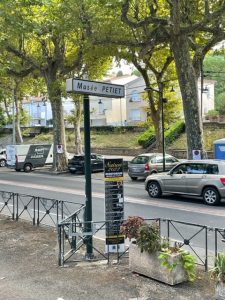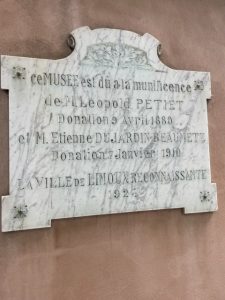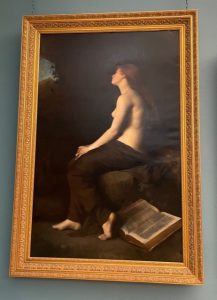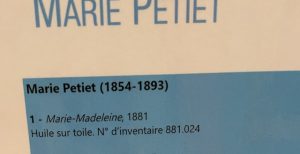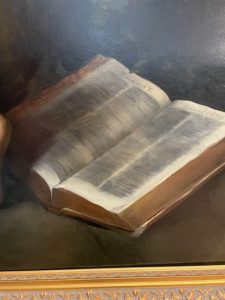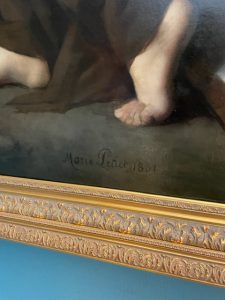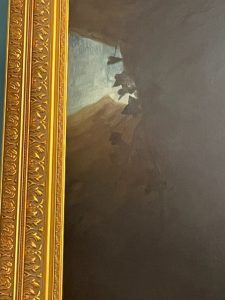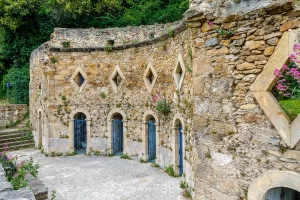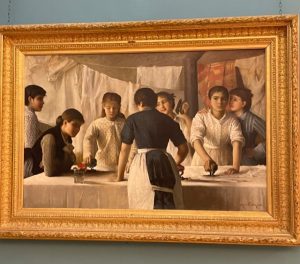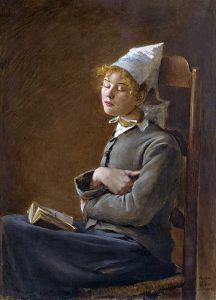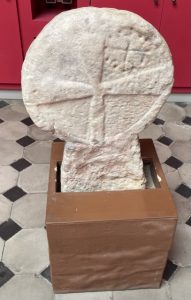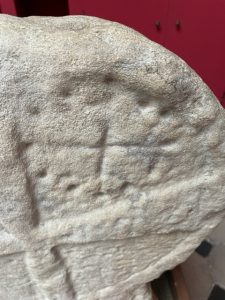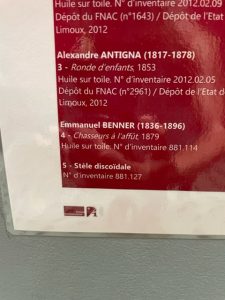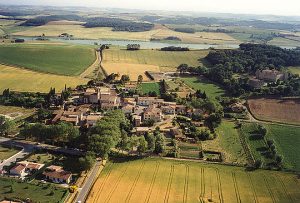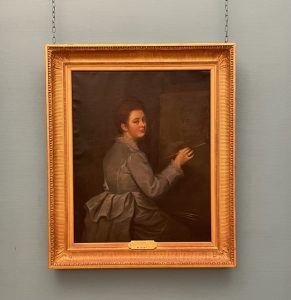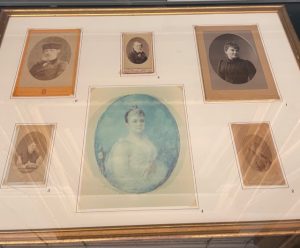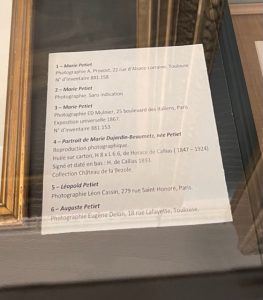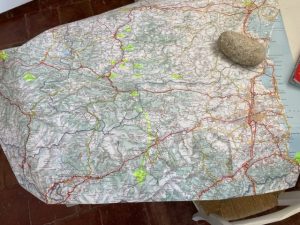Mediterranean
Dayle in Limoux – Day #81
September 25, 2022Gratitude is a quality similar to electricity: it must be produced and discharged and used in order to exist at all. -William Faulkner
My great-grandma’s name, Alma. Alma Evalo Latta. Who gave me a mother’s love when mine was incapable of giving.
The grand parent is able to relinquish center stage and to stand on the sidelines, and thus be in solidarity with those who need their support. Children can feel secure in the presence of their grandparents because, while their parents are still rushing to find their way through life’s journey, grandpa and grandma have hopefully become spacious. They can contain problems, inconsistencies, inconveniences, and contradictions—after a lifetime of practicing and learning.
Grand parents can trust life because they have seen more of it than younger people have, and they can trust death because they are closer to it. Something has told them along the way that who they are now is never the final stage, and this one isn’t either. We need to be close enough to our own death to see it coming and to recognize that death and life are united in an eternal embrace, and one is not the end of the other. Death is what it is. I am a grand father when I am ready to let go. To the grand mother, death is no longer an enemy, but as Saint Francis called it, a “welcome sister.” -Father Richard Rohr
I chose this place to stay in Collioure, on the Mediterranean, because of my grandma who I miss everyday and talk with in my prayers and meditations. When we arrived after a day of back road DRIVING IN FRANCE (WHAT?!),
[A Citroën in France. Bien sûr.]
[Thank G A I A for co-pilots.]
it was not what was advertised, not so much structures on a beach connected by private platforms,
but na extremely dirty once white tent on rocks with no windows and a bathroom quite far away. We didn’t have what we needed for a cold night of rain and thunderstorms…in a tent. <sigh> Alma is camping, not ‘glamping.’ So we left and went searching for a new place, on a Saturday. Pas bon. Looked at a Templar hotel, with a window opened to access pigeons in a dark, damp, alley. No merci. Finally, we landed, Grand Hotel Du Golfe, on the Gulf of Lion. Tres bon.
The colours of Collioure, a small village, home to about 2,800 people, in the south of France. It’s just over 2 hours to Barcelona.
[Image: whereistara]
Matisse, Soutine, Gauguin, Picasso, Miró. All artists who made pilgrimage to Colloure for the colours…
Picasso
Matisse
A perfect good morning in Collioure.
Qu’est-ce tu as fait aujourd’hui?
What did I do today? I explored Southern France with two of my most favorite people on the planet, Annie Glenn and Michael Gillette. Radical Grace. Thanks be to you, dear Gaia. (I miss you William Henry.)
Aujourd’hui?
Exploring the ruins of Puilaurens and Montsegur, traveling the back ancient roads of Landguedoc/Occitanie. ღ
Father Richard Rohr reminds us today,
Saint Thérèse of Lisieux (1873–1897) called a simple, childlike path her “little way.” It is a spirituality of imperfection. In a letter to priest Adolphe Roulland (1870–1934), she writes: “Perfection seems simple to me, I see it is sufficient to recognize one’s nothingness and to abandon oneself as a child into G A I A ‘s arms.” Perfection is, in fact, our ability to include, forgive, and accept our imperfection. As I’ve often said, we grow spiritually much more by doing it wrong than by doing it right. That might just be the central lesson of how spiritual growth happens, yet nothing in us wants to believe it.
If there is such a thing as human perfection, it seems to emerge precisely from how we handle the imperfection that is everywhere, especially in ourselves. A “perfect” person ends up being one who can consciously forgive and include imperfection rather than the ones who think they are totally above and beyond imperfection. It becomes rather obvious once we say it out loud.
F
O
R
G
I
V
E
N
E
S
S
Our greatest gift to give. jai
Finding light’s colour.
[Collioure]
À bientôt.
❀
Dayle in Limoux – Day #67
September 11, 2022R
O
U
E
N
F R A N C E
Jeanne d’Arc
Early train from Limoux to Carcassonne to make the connection to Marseilles and then on to Rouen, France, where Joan of Arc was tried and convicted, betrayed by her king and her country, and burned at the stake for being a heretic, that is, a w i t c h. The guys also didn’t like the fact that she wore armor and men’s clothing, which she donned, especially when in prison, to protect herself against sexual assault. (There’s a new play in London called ‘I, Joan’ about a gender non-conforming hero who uses them/they pronouns. It’s playing at Shakespeare’s Globe. Hard pass. I revere her history, and this isn’t it. She is sacred. Leave her be.)
Very long day of train travel to get to Rouen, which I loved. Train travel is the best; and it’s so doable in this country. And not very expensive. Taking the bus is basically a euro in the region of Languedoc.
Waiting for the train in Limoux.
Waiting for the train in Carcassonne.
And the bread of life.
Pain au chocolate. ღ
The Mediterranean heading into Marseilles, where Mary Magdalene landed in Gaul (France) to begin her apostleship to the villagers in the region. (Read, ‘The Manuscript!’)
Marseilles found my stress threshold. B i g station. Had no idea what I was doing; our train was delayed in Carcassonne which put us late into the station. I couldn’t find the right platform, or a screen to tell me which platform it should be. I had 15 minutes to figure it out. A woman with a child was asking people for €’s, as I was hurrying past I gave her the 4 €’s I had in my pocket. Then she started following me. She wanted 10. Impressive. I finally found the platform with minutes to spare…and lots of perspiration.
Another great thing about France, they even grow trees inside.



The first thing I saw when I disembarked from the train…
I have no idea what it is, no markings…I just love it. So old. And the air smelled like flowers. Seriously! It really did. So fresh. Maybe because I was finally able to remove my mask after five hours. :)
[Train station in Rouen.]
When the taxi dropped me at my hotel, I thought I was in a fever dream.
WHAT. IS. HAPPENING.
The Cathédrale Notre-Dame de Rouen was awash in bright colors and pulsating music. It was incredible. My hotel is right across from the Cathedral. So when it was over, I grabbed my bag to go check in. Door locked with a note in English. I think for me. Finally the proprietor comes downstairs to inform me the hotel is overbooked…staff error…and found me another hotel. Drag. So tired. So, I trekked to find it. Got lost. A sweet young Norwegian couple who spoke English (!), helped me find it. It’s a trip. I can only possibly explain it by suggesting you think 60’s, Batman, Pop Tarts, and Bowling.
Oh, and fluorescent orange and blue lighting. The whole night feels like a fever dream. Toto, we’re not in Limoux anymore. Only have to stay one night and then I can return back to the Hotel Cardinal for the rest of my stay.
On the way to find the other hotel found this tower/obelisk structure…ancient…no markings…and not really cared for. It almost looks like it was burnt at one time.
And the full la lune in Rouen. Here’s what Power Path has to say about this month’s full corn/harvest moon.
This is a good window to focus on spiritual and emotional wellness, what that means to you, and how you can better support it in your life. Any spiritual searching and intention in this area will bring good results. This is also a time for gratitude for what is ending or changing in your life. Completions can be powerful catalysts for driving much needed resets. If a recent crisis has opened up the field of flexibility and creative problem solving, see it as a gift instead of an obstacle.
Almost full before I left Limoux.
Tomorrow, exploring!
I traveled to Rouen to be with Joan. I had thought about this journey so much while still in the states. I so wanted to be here, and here I am! I had hoped to visit the town where she was born and where she first heard the voices instructing her what she needed to do for France; she was only 13/14. The town is called Domrémy-la-Pucelleyet, it’s another five hours and about five transfers. Very remote. I think another time. Folks can visit the church where she worshiped, as well as the home where she lived.
She was only 19 when tried, convicted, and burnt at the stake as a heretic, or as the men liked to call women they didn’t like (and still do), a witch.
I read Mark Twain’s book about Joan of Arc while deep in our COVID isolation, so surprised to learn he had written about her.
It’s excellent. Deep research and reverence for her passion and loyalty for France and her king. Johanne listened to the guidance of her angel spirits, Archangel Michael, Saint Margaret, and Saint Catherine of Alexandria. (St. Catherine of favorite of mine, too.)
Twain wrote:
“It furnished me seven times the pleasure afforded me by any of the others; twelve years of preparation, and two years of writing.”
[https://www.worldcat.org]
[https://www.gender.ed.ac.uk/witches-of-scotland-a-campaign-to-right-the-historic-wrongs-done-to-women/]
More on witches about an original text:
The Malleus Maleficarum, first published in 1486–7, is the standard medieval text on witchcraft and it remained in print throughout the early modern period. Its descriptions of the evil acts of witches and the ways to exterminate them continue to contribute to our knowledge of early modern law, religion and society. Mackay’s highly acclaimed translation, based on his extensive research and detailed analysis of the Latin text, is the only complete English version available, and the most reliable. Now available in a single volume, this key text is at last accessible to students and scholars of medieval history and literature. With detailed explanatory notes and a guide to further reading, this volume offers a unique insight into the fifteenth-century mind and its sense of sin, punishment and retribution.
Found a great short podcast about the thousands of women who were persecuted, tortured and killed after being accused of witchcraft. The Scottish Parliament is set to clear their names. The host, Annette Young, meets the two women who are behind the campaign to get Scottish authorities to pardon the accused.
“At a time when women were not even allowed to speak as witnesses in a courtroom, they were accused and killed because they were poor, different, vulnerable, or in many cases just because they were women … I extend a formal, posthumour apology to all those accused, convicted, vilified or executed under the Witchcraft Act of 1563.”
On the 9th of March 2022, First Minister of Scotland Nicola Sturgeon formally apologised for the persecution of people accused of witchcraft in Scotland, calling it an “injustice on a collosal scale.” The persecution started in the 1500s and lasted over two centuries, during which nearly 4,000 – the vast majority of whom were women – were accused of witchcraft. And this same brutality caused tens of thousands to be persecuted and murdered in Languedoc in the 11th and 12 centuries.
FRANCE 24
Exorcising the ills of the past: Scotland set to vote on pardoning ‘witches.’
https://podcasts.apple.com/us/podcast/the-51/id1055024600?i=1000578178243
Plus demain! (More tomorrow.)  __________________________________________________________________________________________________________
__________________________________________________________________________________________________________
Dayle in Limoux – Day #63
September 6, 2022Crazy discovery today in Limoux at a lovely little museum called musée Petiet de Limoux.
Marie was born and lived in Limoux until her early 30’s. It was after her dad died, also an artist, that she married and moved close to Paris. The discovery? Finding a Mary Magdalene painting! I think I actually exhaled an audible gasp.
Marie was a beautiful painter. So talented. Look at her detail, and use of light & dark.
The photo on the right you can see she signed this painting with the year, 1881. She has positioned Mariam in a cave here in the Languedoc region, and she’s gazing at a hill in the distance.
Could it be Rennes-les-Chateau, where the church of Mary Magdalen is located, or Le Bézu…maybe Bugarach? Trying to research and learn more. Many caves in this area, the Languedoc region, with theories and stories enveloping them. I have been to one where it is believed Mary Magdalene visited, near Rennes-les-Bains. She reportedly administered baptisms in the river there, River Sals. There are healing waters in that little ancient village, which at one time were frequented by Romans.
Many authors and artists convene and live there now, as well as a small, private group of people who still practice the Cathar ways. This is where Sir Henry Lincoln lived. [Holy Blood, Holy Grail]
MARIE PETIET
FRENCH, 1854–1893
‘Marie Petiet began her artistic training with her father and uncle, who were wealthy landowners and amateur painters. Between 1877 and 1883 she studied in Paris with the painter Jean-Jacques Henner and exhibited regularly at the Salon. In 1886 she married the painter Étienne Dujardin-Beaumetz and continued to paint and exhibit her works, many of which were inspired by the working-class community in which she lived in the south of France.’ [Women Artists in Paris]
Marie was only 38 when she died. She did not have children. She reportedly lost her life to cancer.
The other discovery. Oh mon Dieu. Couldn’t believe it. From the 10th century.The identifier is listed at #5. Not much information. Yet researching later I found this:
The Limoux museum also displays a discoidal stele found at Baraigne.
Baraigne is a commune in the Aude department in the Occitanie region of southern France.
‘Along the roads, you will see these surprising little funereal monuments.
The stelae are funereal monuments that date back to around the 10th century. With a solid surface, the stelae are made up of two parts: a foot of varying shapes surmounted by a disc. They are an integral part of the small heritage in the Lauragais.
Since ancient times they have been placed at the side of the deceased’s head to mark the location of the burial. Some think that they used worn grinding wheels which would explain their circular shape. They signal the presence of a grave and evoke the memory of the person buried through sculpture, of tools or a symbolic sign. Sometimes, they can also serve as milestones on Jacobean routes or mark a place of devotion’ [en.castelnaudary-tourisme.com]
This is a self-portrait Marie Petiet painted.
And here are photographs of Marie and her family.
[photo identifier]
A day of discovery and research. Almost finished with ‘The Manuscript.’ More tomorrow. ℒℴve this book.
Plotting my next adventure, either south to the Mediterranean to visit an ancient village, or north to visit the villages of Joan of Arc.
Bonne nuit.



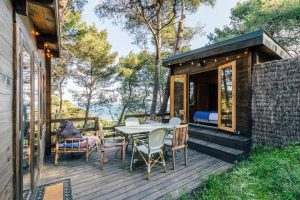

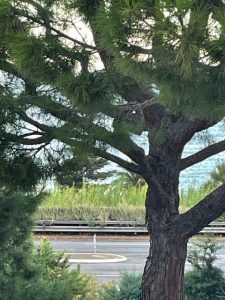
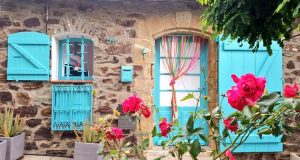
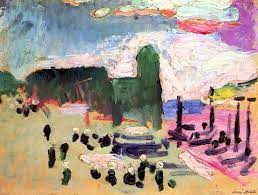

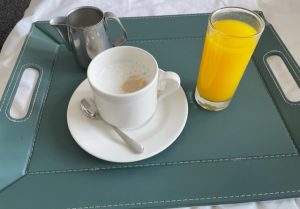

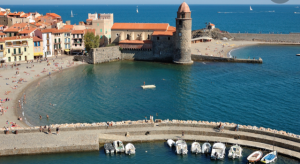

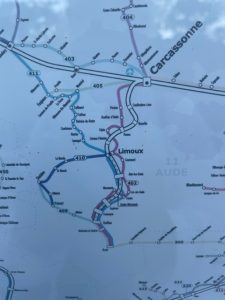

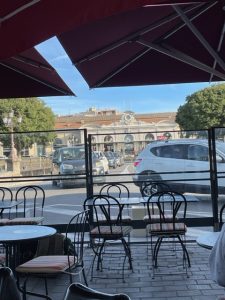
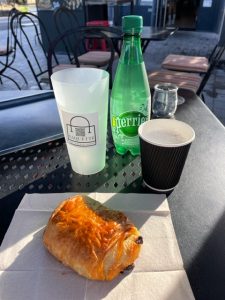
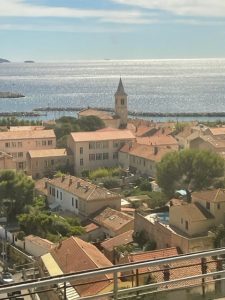



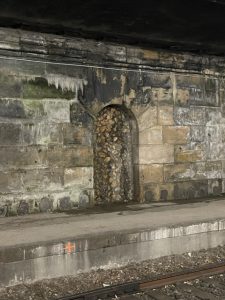
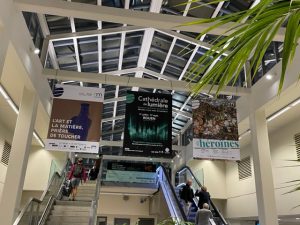
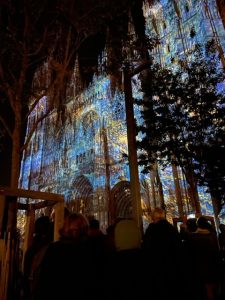


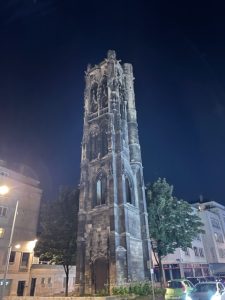
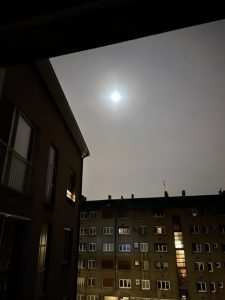
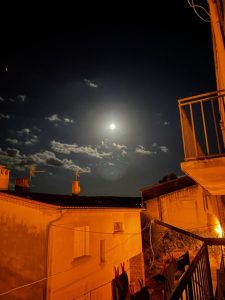




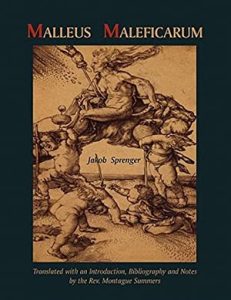
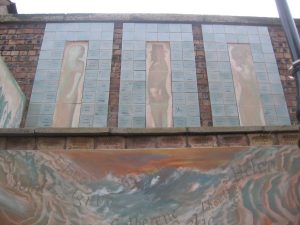

 “It should have been my mum.”
“It should have been my mum.”